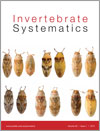The genus Lachnopus Schoenherr (Coleoptera : Curculionidae : Entiminae : Geonemini Gistel), with 66 species described to date, is the largest and most widespread entimine weevil genus in the Caribbean region. The monophyly and internal phylogenetic composition of Lachnopus are tested, using a cladistic analysis of 61 adult morphological characters of 31 ingroup species and five outgroup taxa representing the genera Diaprepes Schoenherr, Exophthalmus Schoenherr, Pachnaeus Schoenherr (all Eustylini), Ischionoplus Chevrolat (Geonemini) and Apodrosus Marshall (Polydrusini). The analysis produced two most parsimonious cladograms with a length of 167 steps, a consistency index of 36 and a retention index of 73. According to the strict consensus and preferred character state optimisations, the examined species of Lachnopus do not form a monophyletic entity, even though most species are placed in a major L. coffeae–L. guerinii ingroup clade, which stands in sister relationship to Ischionoplus. This major clade is constituted by at least three well-recognisable subgroups, each associated with a particular geographic range in the Caribbean region: (1) a widely distributed L. coffeae–L. lineicollis ‘grade’; (2) the Hispaniolan L. proteus–L. mercator clade; (3) and the L. hispidus–L. guerinii clade with species from Cuba, Florida and Jamaica. This study provides a sound phylogenetic basis for future revisions of Lachnopus and related geonemine genera.
How to translate text using browser tools
19 June 2012
Phylogenetic assessment of the Caribbean weevil genus Lachnopus Schoenherr (Coleoptera : Curculionidae : Entiminae)
Jennifer C. Girón,
Nico M. Franz
ACCESS THE FULL ARTICLE

Invertebrate Systematics
Vol. 26 • No. 1
June 2012
Vol. 26 • No. 1
June 2012




